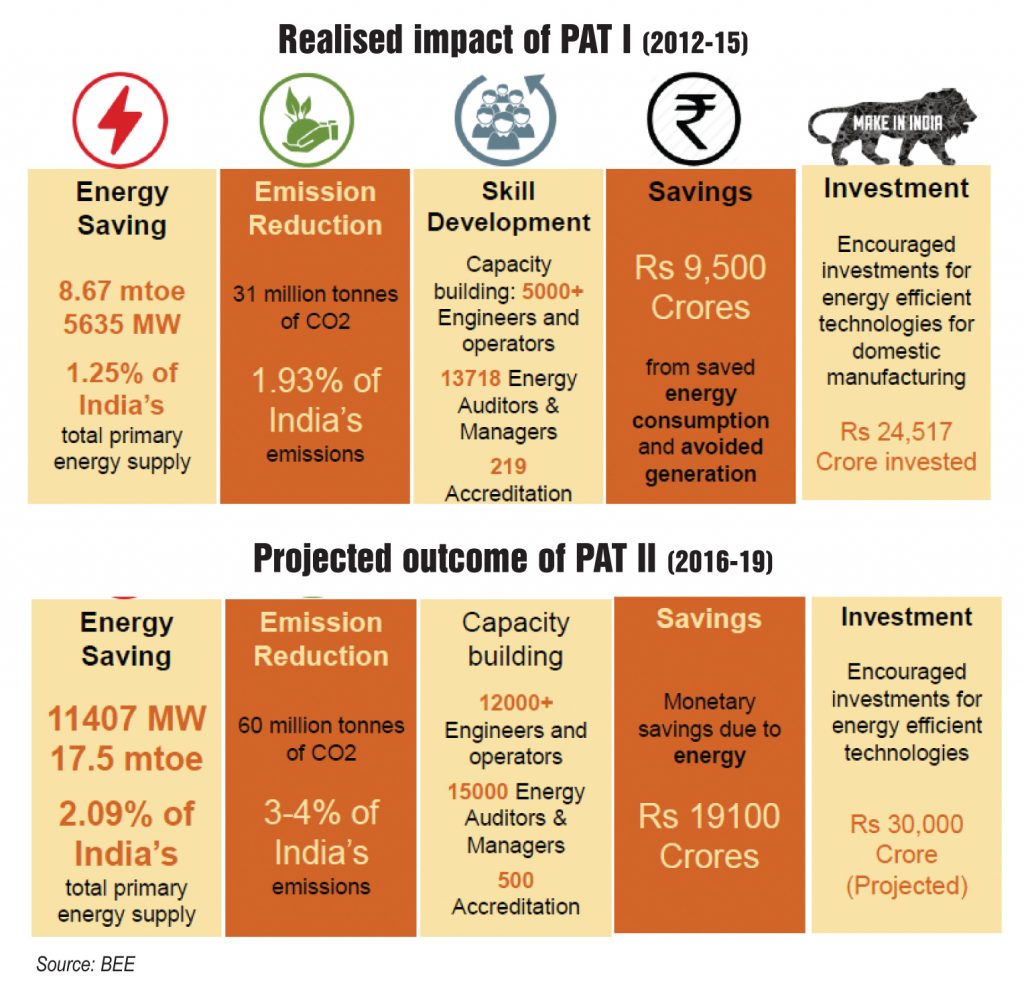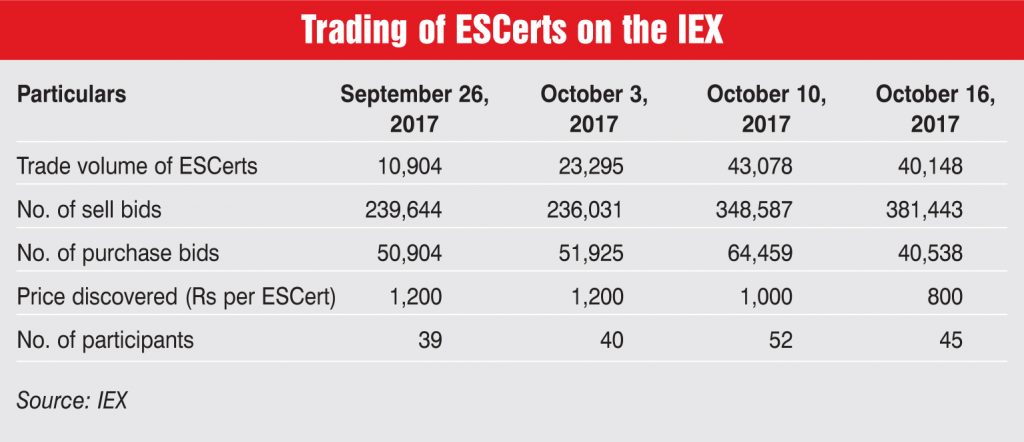
The much-awaited trading of energy saving certificates (ESCerts), issued under the Perform, Achieve and Trade (PAT) I scheme, commenced on September 26, 2017. Against the backdrop of a sound regulatory and policy framework, ESCerts trading has attracted a positive response from stakeholders. So far, over 100,000 certificates have been traded. Meanwhile, the PAT II and PAT III cycles were introduced in 2015-16 and 2016-17 respectively. Since the blueprint of the new cycles has been prepared based on the learning from PAT I, the energy consumption targets under these cycles are more equitable and more stringent across sectors. Besides, these cycles have wider coverage, in terms of both designated consumers and sectors.
PAT I
In the first cycle of PAT (compliance period 2012-15), 478 designated consumers were covered across eight energy-intensive sectors. These sectors are aluminium, cement, chlor-alkali, fertiliser, iron and steel, pulp and paper, textiles, and thermal power. An investment of Rs 245.17 billion was made in energy efficient technologies for compliance under the scheme. The cycle witnessed energy saving of 8.67 million tonnes of oil equivalent (mtoe), 30 per cent higher than the targeted energy saving of 6.89 mtoe. This led to the reduction of 31 million tonnes of carbon dioxide emissions and saved 5,635 MW of generation capacity. The cycle resulted in monetary savings of Rs 376.85 billion. After evaluating the energy consumption of the designated consumers under PAT I, the Ministry of Power (MoP), in March 2017, issued over 3.8 million ESCerts to those that exceeded their energy saving target.
All sectors, except for thermal power, significantly overachieved their energy saving targets. The paper and pulp sector recorded savings of 0.26 mtoe (117 per cent higher than the target), chlor-alkali recorded 0.1 mtoe (100 per cent higher), cement 1.44 mtoe (76 per cent more), the fertiliser sector recorded savings of 0.83 mtoe (73 per cent more), textile 0.12 mtoe (71 per cent higher), aluminium 0.73 mtoe (59 per cent), iron and steel 2.1 mtoe (41 per cent), and thermal power plants (TPPs) recorded 3.06 mtoe of savings (5 per cent lower than the target).
Trading of ESCerts
As of October 10, 2017, four rounds of ESCert trading have been concluded and a total of 117,425 ESCerts have been traded. The average number of sell bids (ESCerts) received in one trading session was 301,426, while the average number of purchase bids was 51,957. Further, the average price discovered was Rs 1,050 per ESCert.
The trading of ESCerts is governed by the Central Electricity Regulatory Commission [CERC] (Terms and Conditions for Dealing in Energy Savings Certificates) Regulations, 2016, notified in May 2016. These regulations define an institutional framework to facilitate ESCert trading. Under the framework, the CERC is the market regulator, the Bureau of Energy Efficiency (BEE) is the administrator, the Power System Operation Corporation is the registry, while the Indian Energy Exchange and Power Exchange India Limited are the trading platforms.
Regarding the registration fee and other charges for ESCerts, the CERC issued the fee order in March 2017 under the aforementioned regulations. In addition to a one-time registration fee of Rs 15,000, the designated consumers need to pay an additional fee of Rs 5 for each ESCert issued to them by the MoP. Further, in order to encourage greater participation, the CERC has waived the one-time registration fee for those registering before December 31, 2017. The BEE had proposed the waiver and agreed to reimburse the registration expenses of the entities.
For trading of ESCerts, the eligible entities place their buy/sell bids on the power exchanges. These bids are sent to the registry for verification. Thereafter, the exchanges aggregate buy bids and confirmed sell bids to discover the market clearing price and market clearing volume through a closed double-sided uniform price auction. ESCert transactions are carried out every Tuesday on a first-in-first-out principle.
With regard to validity, each certificate has a life of two cycles with a particular consumer. The ESCerts secured by the consumers in PAT I can be used till the end of PAT II. Apart from this, buyers can purchase ESCerts beyond their compliance targets in a respective PAT cycle. However, once purchased these cannot be resold. Designated consumers might see economic sense in banking the certificates secured under PAT I to meet the targets in the next cycle given the oversupply of ESCerts in the market.
PAT II and PAT III
The coverage of PAT II (compliance period 2016-19) has been increased both in terms of sectors as well as the consumers covered under each sector. Three new sectors have been introduced in this cycle, refinery, railways and electricity distribution, which together account for 45 per cent of the country’s industrial electricity consumption. The cycle extends to a total of 621 designated consumers (DC) with a total energy consumption of 227 mtoe. In this cycle, 84 new designated consumers have been added from the existing sectors under PAT I, while 84 have been added from the new sectors. During the cycle, energy savings of 8.87 mtoe are expected. Meanwhile, PAT III (compliance period 2017-20) extends to 116 DCs across six sectors. These sectors are aluminium, textile, pulp and paper, iron and steel, cement and thermal power. Against the energy consumption of 34.17 mtoe, the targeted energy savings under the cycle stand at 1.01 mtoe.
The consumption norms for PAT II and PAT III are tighter as compared to the previous cycle. Industry experts opine that the energy saving target under PAT I was fairly easy to meet. Designated consumers had a host of easy-to-adopt energy saving solutions at their disposal. However, meeting the targets set under the new cycles is going to be a challenge. Process innovation and technological advancements are expected along the production line to curb energy consumption.
So far, PAT has managed to deliver the desired results with regard to curtailing energy consumption. However, in order to obtain energy efficiency in industrial operations at the pan-Indian level, the scope of the scheme needs to be expanded to include more sectors. There is also a need to promote technological advancements in the energy efficiency domain through financial sops, develop an ecosystem for promoting energy efficiency, and undertake capacity building of stakeholders.






